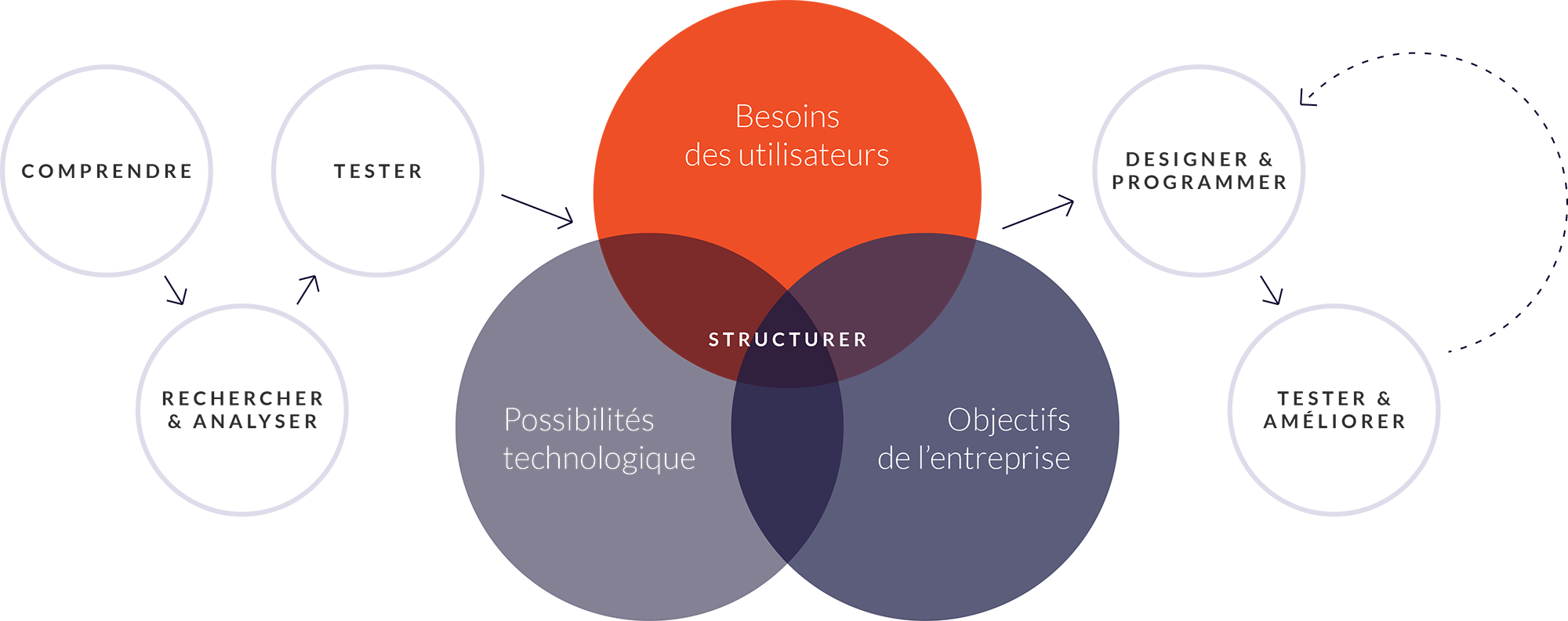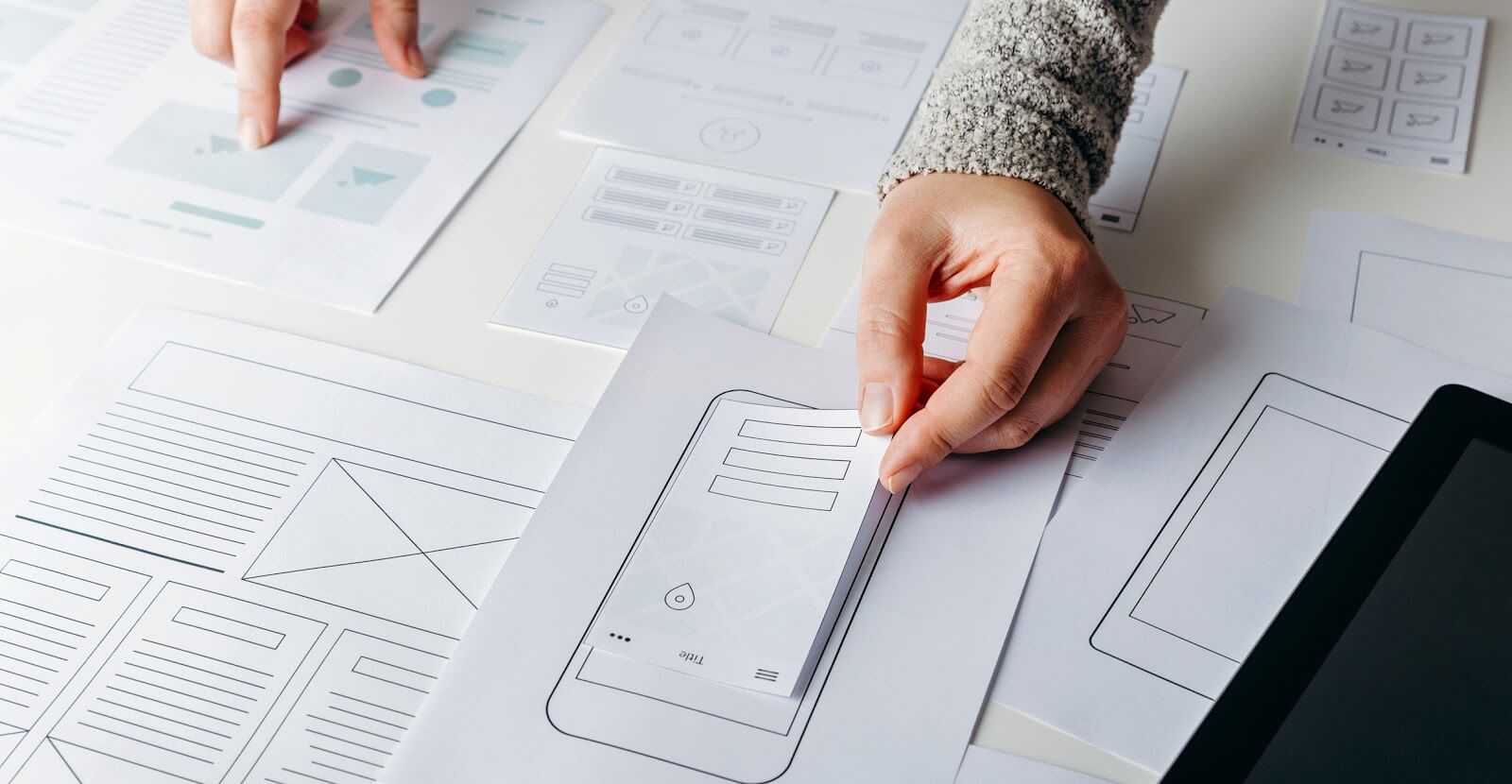You've probably already heard someone around you talk about UX (user experience) or even UI (user interface) design. Although these terms are often used, they are now often victims of the trend of the moment. Does it sound better in a conversation to say "We changed the location of this call to action to improve the user experience" or "We changed the location of this button because it's common sense, people read from left to right". Today, it seems more professional to talk about user experience than common sense, but what is it really?
First of all, it is important to know that these terms appeared following the complexity of the web and the rise in importance of the mobile platform. The UX is not new, it is even present in all spheres of our lives, whether it is for a door handle, a bottle of ketchup or the route we follow at the airport. If you've ever been lost in a building because of a lack of directions or because some signs were not in the right place, you've had a bad user experience. The same goes for your website, your application or your software.
In recent years, we have seen the emergence of the roles of UX Designer and UI Designer in the field. Most web designers are now UX/UI designers, but some companies, due to their size and/or the division of their departments, hire people specialized in one or the other. Although sometimes treated separately, these two specialties are part of a globality that consists in improving the design and organization of an online platform, and thus making users want to come back to your site.
The improvement of the user interface (UI) is one of the steps to follow for an optimal improvement of the user experience (UX) of your platform. It will make navigation easier and more intuitive by working on the fluidity of animations, the visibility of elements and the efficiency of the design.
As mentioned earlier, user experience (UX) starts with common sense. However, if you take the time to do it right and with the right tools, there are ways to better measure the factors that will improve the simplicity, speed, intuitiveness of the navigation, and therefore the conversion of users on your platform. Which brings us to the next question...
In today's competitive digital environment, user experience matters. UX used to be a luxury and an added expense. Now, good UX is the key to success. Without UX, you run the risk of decreased sales, decreased efficiency, increased training and development costs, and being outperformed by competitors.
The user interface (UI) is usually the element of UX that is most often optimized. Being the visible part, people tend to mistakenly believe that a spectacular and out of the ordinary design will solve all their problems. Although the aesthetic side of your website is not to be neglected, it is important not to forget the hidden part of the iceberg: the scientific data. A carefully designed interface, informed by research and validated by data, will further improve your users' conversion. Engagement is key, and that's where a strong visual will serve you well.
If you're working solely on design intuition, you're missing the opportunity to compile data that will help you in understanding what users want and what will drive their behavior. By establishing concrete metrics and measurements, you can also develop a plan and improve your website, app or software iteratively over time. We recommend using research, analysis and testing to validate that your user interface (UI) will meet your goals.
For these reasons, among many others, the importance of science is clear. Visual style will capture a user's interest and engage them, but science will validate that the visual design decisions you make are in line with your company's goals and objectives, not just your visual tastes.
Now, how much does it cost? That was our initial question. As you can imagine, there are many factors to consider and a multitude of tools and techniques available to achieve your goals. It is therefore impossible to define a price without having evaluated your needs and your objectives. Here is the path and the possibilities that are offered to you at Walter:
It is crucial to know where you are coming from and where you want to go so that the next steps fit well together. You can think of this step as the foundation of your website.
- What is your business model?
- What are your company's goals?
- What features are required?
- What are your technological constraints?
User-centered design begins with the definition of objectives and goals. It lays the foundation for strategy, design, content and information architecture. Business priorities often leave out the reality of user needs. What works and matters to users is not always what works for us. At the research stage, we help you uncover the gaps in your knowledge at this level and align your assumptions with real user expectations. We help you identify a strategy that meets both user needs and business objectives. Our analytical approach focuses on gathering strategic information to better understand your customers' reactions and interactions with your platform. Depending on the time and resources available, we choose the research methods that best suit you.
- Developing personas
A tool that will help you better understand a subset of users. The persona takes attributes of similar users and combines them with the description of a single target group. It brings out details about the attitudes, behaviors, pain points, preferences, lifestyles and motivations of that user group.
- Competitive Analysis
The process of comparing a product to other similar products on the market allows us to better understand the features, strengths and weaknesses, branding and user experience of products already available.
- Conversion Rate Analysis
"Converting" doesn't just mean making a sale. Having a good conversion rate can mean all sorts of measurables. Unless you clearly define what you expect as "conversion", you will not achieve your goal. Learn more about conversion rate optimization in our article on this topic.
- Surveys
It is possible to create a survey that will be sent to your target audience to get feedback, ask questions about the overall experience and get information about the effectiveness of features. This is a cost-effective way for designers to obtain information, even if it is not as in-depth as user testing.
- Pain Point Analysis
Sometimes a problem can create frustration or inefficiency in the user's navigation. In the early stages of our research, we may discover these problems by asking users what solutions they currently use to meet their needs. The current solution might not be quite adequate for the user to achieve their goals, either its execution is unpleasant or it takes too much time. By obtaining this information, designers have the opportunity to make improvements to the product.
- Focus Group
Bringing together a group of people allows us to ask questions and have discussions that will allow us to find commonalities in people's experience and attitude towards your product.
Based on the objectives defined at the beginning of the UX process, we help you establish the appropriate key performance indicators. Walter can conduct user testing sessions and perform detailed analysis to turn the data into actionable design improvements. We use a variety of methods to gather user feedback, from remote user testing to face-to-face sessions. We'll help you choose the ones that work best for you and your participants. We love surprises and are always open to discoveries that can help us improve your platform.
- Screener
A set of questions asked to research participants about potential users to ensure that they are part of the target audience. This screening helps maximize research budgets and control the quality of results by ensuring that only qualified respondents are allowed to participate in the study.
- 5 second test
A quick 5-second exposure allows us to observe what users remember first about your product.
- Trust test
During the 5-second test, users are asked how they perceive the credibility of the page, and if they feel confident enough in the site to make purchases or provide personal information.
- Usability testing
A test that consists of observing the user's interactions with the interface to see how easily they can accomplish tasks, whether they have problems with the interface, and whether users have problems that the designers would not have anticipated.
- Error analysis
An error made by a user during a usability test, whether accidental or not, allows us to identify a problem in the interface design. We also pay particular attention to users who click on unclickable elements, who search for a feature in the wrong place, who enter the wrong type of information in a text field, and any other error that points to a potential improvement to be made.
- Think Aloud
A testing method where users think aloud while using a system. This allows us to learn more about what people are thinking when determining how to navigate a new interface.
Ensuring that the visual structure and presentation of information on a platform is intuitive and correlates with user expectations is one of the foundations in optimizing the user experience. We make sure that the right information is presented in the right way, at the right place and at the right time. Wireframes help you visualize data structures and represent user interface functionality. They allow for effective communication between team members and, most importantly, they allow for quick testing of workflows, navigation and overall data structure.
- Architecture and information hierarchy
Creating or adjusting your tree structure is a good starting point to structure your site for optimal navigation. Ideally, the hierarchy of your information should correspond to your objectives, so that the most important information is the one that will be most visible on the page.
- Creation of workflows
This step helps us list the different paths that will be taken through the application, software or website. It starts at the entry point and follows the intermediate steps of the process, until its completion.
- Wireframes
Our team will provide you with a preliminary visualization of the interface layout. This step does not contain fonts, colors or text and focuses only on the relationship between the different objects on the page. The purpose of wireframes is to explore how the structure of the site will work, without being distracted by irrelevant visual details at this point.
The visual appeal of your product has a huge impact on users. While the information architecture of a product is important, it does not facilitate engagement in and of itself. We use user-centered design to produce a consistent, predictable and desirable effect on the target audience. By targeting users at a deeper, more emotional level, we make the user experience more enjoyable. The change in experience is accomplished by eliciting an emotional response from the user related to their actions and accomplishments. One of the main goals of UX design is to add context to users' natural behavior and, in doing so, provide them with a story they can draw from the experience. We also ensure that your product is part of the unified entity of your brand and that it is presented with the required level of integrity.
With years of experience, we ease your burden by ensuring that your platform looks and feels exactly like the approved visuals and has been properly tested on different screens. Using the latest technologies, we ensure that the design is translated into working code. We code strictly in accordance with current standards and assist you with more complex back-end integrations.
- Creation of a Moodboard
Searching for visual inspirations (such as fonts, colors or images) that capture the emotional response a brand or site should elicit. In the early stages of design strategy, the moodboard can help set the tone for all design choices made during the mock-up and prototyping stages.
- Mockup creation
A design tool for pinning down the final graphical elements of an interface. Rather than focusing on functionality, a mockup describes the appearance of the interface.
- Demo
The demo that will be provided to you is a preliminary version of your platform that allows us to test the features and make some small adjustments before it goes live.
Although we have done some testing and analysis beforehand to optimize your site to its fullest potential, it is important to know that there is no end to the optimization of a website. In order to stay ahead of your competitors, you will have to stay on top of new trends and user evolution. Our clients who understand that continuous improvement is the key, are the ones who get the best return on their investment.
- A/B testing
This involves showing users one of two versions of the same page and determining which one performs better in terms of metrics, such as conversions or click-through rates. Pages typically include a change to a single feature, such as color, text or button placement.
A high level of user satisfaction will ensure your company's growth and sustainability. You can achieve this goal by creating a high-quality product. Improve your reputation today by investing in UX.
Ultimately, a good user experience leads to a great one:
- Improved performance - Products that work better
- Increased exposure - Better products and good word of mouth marketing
- Improved credibility - More interest and trust in the brand, resulting in a lower bounce rate
- Long-term reductions in design and development costs - More economical initial investment of time/money
- Increased sales - Improved conversion
- Reduced training and errors - More productivity and efficiency for users
We recommend investing in UX, both on the scientific and aesthetic side, to create products that will charm users. Calculating the ROI of UX is a good place to start convincing your partners that it's worth it.
Want to know more? Don't hesitate to contact us to speak with an expert.








